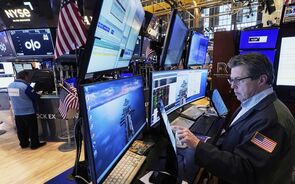GoBulling Research - SP nos 900 pts
2 mensagens
|Página 1 de 1
Olá Salvador 
Deixo aqui o gráfico de longo prazo que também já coloquei no tópico sobre o SP500 que vou actualizando quando posso.
Pelo menos os 1080 parecem ser totalmente possíveis.
Os 900, quem sabe? Mas será algo que não será bonito de ser visto....
Este parágrafo é o que mais temo, pois muita gente pode (e já está a ser afectada):
"The credit crisis is weighing heavily on the financials and we expect a negative spillover effect into the industrial sectors in the upcoming quarters (more on this below). A recession in the US and Europe is inevitable and the Equity markets haven’t fully priced that in. "
Um abraço
Deixo aqui o gráfico de longo prazo que também já coloquei no tópico sobre o SP500 que vou actualizando quando posso.
Pelo menos os 1080 parecem ser totalmente possíveis.
Os 900, quem sabe? Mas será algo que não será bonito de ser visto....
Este parágrafo é o que mais temo, pois muita gente pode (e já está a ser afectada):
"The credit crisis is weighing heavily on the financials and we expect a negative spillover effect into the industrial sectors in the upcoming quarters (more on this below). A recession in the US and Europe is inevitable and the Equity markets haven’t fully priced that in. "
Um abraço
- Anexos
-
- SPX 17set08daily.PNG (145.14 KiB) Visualizado 442 vezes
GoBulling Research - SP nos 900 pts
Deixo aqui o que veio parar no meu mail...
"
S&P 500 at 900 in 2009
Our outlook for equities remain on the weak side
Given the current market conditions we are revising our equity index targets down. Since the beginning of the year our house view was far more bearish than the consensus and we still believe that we haven’t reached the bottom in the equity markets yet. The credit crisis is weighing heavily on the financials and we expect a negative spillover effect into the industrial sectors in the upcoming quarters (more on this below). A recession in the US and Europe is inevitable and the Equity markets haven’t fully priced that in.
As a consequence to the sharper than expected deterioration of the economic data we lower our index targets by around 10% for the year and postpone the possible slight recovery of the equity markets into the second half of 2009. Given normal market valuations the mid 2009 targets would bring us back on the 50 year long term earnings trend in the S&P500.
Index Targets
Ultimo 2008
Mid 2009
Ultimo 2009
S&P 500
1000
900
950
DAX
5000
4500
4750


Market valuations
The current market valuations look attractive in a historic context (see table below). A PE for the current year around 15 and the next year of 13 is the normal average. Some of the markets are currently trading significant below these figures, but we believe that what you see is not what you will get. From our perspective the earnings have to be revised down by at least another 10% -15%.
If you take the S&P 500 as an example the 2008 earnings have been revised down by 12.3% since the beginning of the year. In the first glance that sounds like a high figure but the interesting part is to look into the sectors. By excluding the earnings revisions of the financial sector you get a totally different picture. The S&P 500 earnings rise by 0.9% driven by an 18.6% increase in the Energy sector, but this was done with an oil price of $150…… Currently 22.6% of the 2008er earnings and 19.9% of the 2009er earnings rely on the Energy sector.
The 2009 S&P 500 earnings are expected to grow by 26%. Most of that is driven by a strong recovery of the financial sector and increase in oil price. How likely is that if you consider that the banks have $80 billion less working capital…… Excluding the financial all sector earnings are expected to grow by 13.1% on average. How likely is that if we see a recession in the US and Europe?
We have a similar picture for the DJ STOXX 600 earnings only that the weighting of the energy sector is around 13%. The biggest contributor to the index earnings is the financial sector with around 28%.
Is it going to get any worse? Oh, yes…
Globally the losses in the banking sector amounts to $518.6 billion, while there has been an injection of capital a total of $364.5 billion. This negative difference is weakening the balance sheets of banks and especially investment banks. If your earnings solely are dependent on investment banking you are in for some beating due the difference between losses and added capital. If we calculate only with a 10% return on your capital in investment banks this alone would amount to an earnings decrease in the neighborhood of $15 billion.
Besides earnings losses investment banks are facing other problems as well. Investors are not willing to invest into sinking ships and consequently we will see investment banks forced to sell off parts of their business under forced liquidation in their search for liquidity. Prices under forced liquidation are usually somewhat lower than under an orderly liquidation. Furthermore we have noticed that rating agencies opt more to downgrade based on market sentiment.
Given the current crisis we also expect that investment banks will be faced with heavy regulation going forward. In short this means that investment banks will have to allocate more capital as a security backup when doing investments. The return of the total equity will head lower on the back of this.
And for the commercial banks the futures looks bleak as well. Bank loans losses where retail customers are default their loans are only just beginning now… earlier banks loans losses were at 0.40%. Currently they are at 1%. If the loans losses increase to 2% (e.g. in case of increasing unemployment) then this would amount to another $300 billion of writedowns for U.S. banks according to our estimates. This will be on the top of the already $300 billion capital market write-downs already realized.
Our current sector focus
Sell banks on strengths as we think there is still more negative news to come, watch for companies with a big debt position who have to roll their credits. We like companies with a strong balance sheet who can benefit from the current situation by gaining market share and/or buying assets cheap.
The below Debt/Capital breakdown clearly show that it is the defensive sectors one should be in, if you want to stay clear of excessive debt.

"
S&P 500 at 900 in 2009
Our outlook for equities remain on the weak side
Given the current market conditions we are revising our equity index targets down. Since the beginning of the year our house view was far more bearish than the consensus and we still believe that we haven’t reached the bottom in the equity markets yet. The credit crisis is weighing heavily on the financials and we expect a negative spillover effect into the industrial sectors in the upcoming quarters (more on this below). A recession in the US and Europe is inevitable and the Equity markets haven’t fully priced that in.
As a consequence to the sharper than expected deterioration of the economic data we lower our index targets by around 10% for the year and postpone the possible slight recovery of the equity markets into the second half of 2009. Given normal market valuations the mid 2009 targets would bring us back on the 50 year long term earnings trend in the S&P500.
Index Targets
Ultimo 2008
Mid 2009
Ultimo 2009
S&P 500
1000
900
950
DAX
5000
4500
4750
Market valuations
The current market valuations look attractive in a historic context (see table below). A PE for the current year around 15 and the next year of 13 is the normal average. Some of the markets are currently trading significant below these figures, but we believe that what you see is not what you will get. From our perspective the earnings have to be revised down by at least another 10% -15%.
If you take the S&P 500 as an example the 2008 earnings have been revised down by 12.3% since the beginning of the year. In the first glance that sounds like a high figure but the interesting part is to look into the sectors. By excluding the earnings revisions of the financial sector you get a totally different picture. The S&P 500 earnings rise by 0.9% driven by an 18.6% increase in the Energy sector, but this was done with an oil price of $150…… Currently 22.6% of the 2008er earnings and 19.9% of the 2009er earnings rely on the Energy sector.
The 2009 S&P 500 earnings are expected to grow by 26%. Most of that is driven by a strong recovery of the financial sector and increase in oil price. How likely is that if you consider that the banks have $80 billion less working capital…… Excluding the financial all sector earnings are expected to grow by 13.1% on average. How likely is that if we see a recession in the US and Europe?
We have a similar picture for the DJ STOXX 600 earnings only that the weighting of the energy sector is around 13%. The biggest contributor to the index earnings is the financial sector with around 28%.
Is it going to get any worse? Oh, yes…
Globally the losses in the banking sector amounts to $518.6 billion, while there has been an injection of capital a total of $364.5 billion. This negative difference is weakening the balance sheets of banks and especially investment banks. If your earnings solely are dependent on investment banking you are in for some beating due the difference between losses and added capital. If we calculate only with a 10% return on your capital in investment banks this alone would amount to an earnings decrease in the neighborhood of $15 billion.
Besides earnings losses investment banks are facing other problems as well. Investors are not willing to invest into sinking ships and consequently we will see investment banks forced to sell off parts of their business under forced liquidation in their search for liquidity. Prices under forced liquidation are usually somewhat lower than under an orderly liquidation. Furthermore we have noticed that rating agencies opt more to downgrade based on market sentiment.
Given the current crisis we also expect that investment banks will be faced with heavy regulation going forward. In short this means that investment banks will have to allocate more capital as a security backup when doing investments. The return of the total equity will head lower on the back of this.
And for the commercial banks the futures looks bleak as well. Bank loans losses where retail customers are default their loans are only just beginning now… earlier banks loans losses were at 0.40%. Currently they are at 1%. If the loans losses increase to 2% (e.g. in case of increasing unemployment) then this would amount to another $300 billion of writedowns for U.S. banks according to our estimates. This will be on the top of the already $300 billion capital market write-downs already realized.
Our current sector focus
Sell banks on strengths as we think there is still more negative news to come, watch for companies with a big debt position who have to roll their credits. We like companies with a strong balance sheet who can benefit from the current situation by gaining market share and/or buying assets cheap.
The below Debt/Capital breakdown clearly show that it is the defensive sectors one should be in, if you want to stay clear of excessive debt.
2 mensagens
|Página 1 de 1
Quem está ligado:
Utilizadores a ver este Fórum: aaugustobb_69, PAULOJOAO e 115 visitantes


